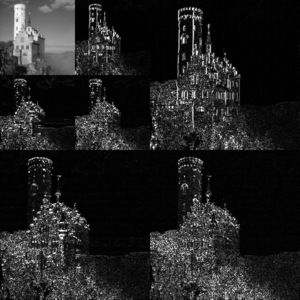- Wavelet transform
-
 An example of the 2D discrete wavelet transform that is used in JPEG2000.
An example of the 2D discrete wavelet transform that is used in JPEG2000.
In mathematics, a wavelet series is a representation of a square-integrable (real- or complex-valued) function by a certain orthonormal series generated by a wavelet. This article provides a formal, mathematical definition of an orthonormal wavelet and of the integral wavelet transform.
Contents
Formal definition
A function
 is called an orthonormal wavelet if it can be used to define a Hilbert basis, that is a complete orthonormal system, for the Hilbert space
is called an orthonormal wavelet if it can be used to define a Hilbert basis, that is a complete orthonormal system, for the Hilbert space  of square integrable functions. The Hilbert basis is constructed as the family of functions
of square integrable functions. The Hilbert basis is constructed as the family of functions  by means of dyadic translations and dilations of
by means of dyadic translations and dilations of  ,
,for integers
 . This family is an orthonormal system if it is orthonormal under the inner product
. This family is an orthonormal system if it is orthonormal under the inner productwhere
 is the Kronecker delta and
is the Kronecker delta and  is the standard inner product
is the standard inner product  on
on  The requirement of completeness is that every function
The requirement of completeness is that every function  may be expanded in the basis as
may be expanded in the basis aswith convergence of the series understood to be convergence in norm. Such a representation of a function f is known as a wavelet series. This implies that an orthonormal wavelet is self-dual.
Wavelet transform
The integral wavelet transform is the integral transform defined as
The wavelet coefficients cjk are then given by
Here, a = 2 − j is called the binary dilation or dyadic dilation, and b = k2 − j is the binary or dyadic position.
Wavelet compression
Wavelet compression is a form of data compression well suited for image compression (sometimes also video compression and audio compression). Notable implementations are JPEG 2000 and ECW for still images, and REDCODE, the BBC's Dirac, and Ogg Tarkin for video. The goal is to store image data in as little space as possible in a file. Wavelet compression can be either lossless or lossy.[1]
Using a wavelet transform, the wavelet compression methods are adequate for representing transients, such as percussion sounds in audio, or high-frequency components in two-dimensional images, for example an image of stars on a night sky. This means that the transient elements of a data signal can be represented by a smaller amount of information than would be the case if some other transform, such as the more widespread discrete cosine transform, had been used.
Wavelet compression is not good for all kinds of data: transient signal characteristics mean good wavelet compression, while smooth, periodic signals are better compressed by other methods, particularly traditional harmonic compression (frequency domain, as by Fourier transforms and related). Data statistically indistinguishable from random noise is not compressible by any means.
See Diary Of An x264 Developer: The problems with wavelets (2010) for discussion of practical issues of current methods using wavelets for video compression.
Method
First a wavelet transform is applied. This produces as many coefficients as there are pixels in the image (i.e.: there is no compression yet since it is only a transform). These coefficients can then be compressed more easily because the information is statistically concentrated in just a few coefficients. This principle is called transform coding. After that, the coefficients are quantized and the quantized values are entropy encoded and/or run length encoded.
A few 1D and 2D applications of wavelet compression use a technique called "wavelet footprints".[2][3]
Other Practical Applications
The wavelet transform can provide us with the frequency of the signals and the time associated to those frequencies, making it very convenient for its application in numerous fields. For instance, signal processing of accelerations for gait analysis[4].
See also
- Continuous wavelet transform
- Discrete wavelet transform
- Complex wavelet transform
- Dual wavelet
- Multiresolution analysis
- ECW, a wavelet-based geospatial image format designed for speed and processing efficiency
- JPEG 2000, a wavelet-based image compression standard
- Some people generate spectrograms using wavelets, called scaleograms. Other people generate spectrograms using a short-time Fourier transform
- Chirplet transform
- Time-frequency representation
References
- Chui, Charles K. (1992). An Introduction to Wavelets. San Diego: Academic Press. ISBN 0121745848.
- ^ JPEG 2000, for example, may use a 5/3 wavelet for lossless (reversible) transform and a 9/7 wavelet for lossy (irreversible) transform.
- ^ N. Malmurugan, A. Shanmugam, S. Jayaraman and V. V. Dinesh Chander. "A New and Novel Image Compression Algorithm Using Wavelet Footprints"
- ^ Ho Tatt Wei and Jeoti, V. "A wavelet footprints-based compression scheme for ECG signals". Ho Tatt Wei; Jeoti, V. (2004). A wavelet footprints-based compression scheme for ECG signals. A. pp. 283. doi:10.1109/TENCON.2004.1414412.
- ^ "Novel method for stride length estimation with body area network accelerometers", IEEE BioWireless 2011, pp. 79-82
External links
- Robi Polikar (2001-01-12). "The Wavelet Tutorial". http://users.rowan.edu/~polikar/WAVELETS/WTtutorial.html.
Categories:- Wavelets
- Functional analysis
Wikimedia Foundation. 2010.




 = \frac{1}{\sqrt{|a|}}
\int_{-\infty}^\infty \overline{\psi\left(\frac{x-b}{a}\right)}f(x)dx\,](2/1b2049956d7f7057f8d01da18e1c7256.png)
](c/0bc7fcad68c62512d70b2d35facf25b6.png)